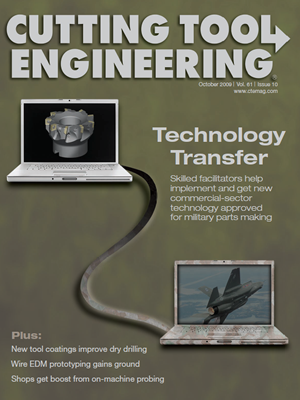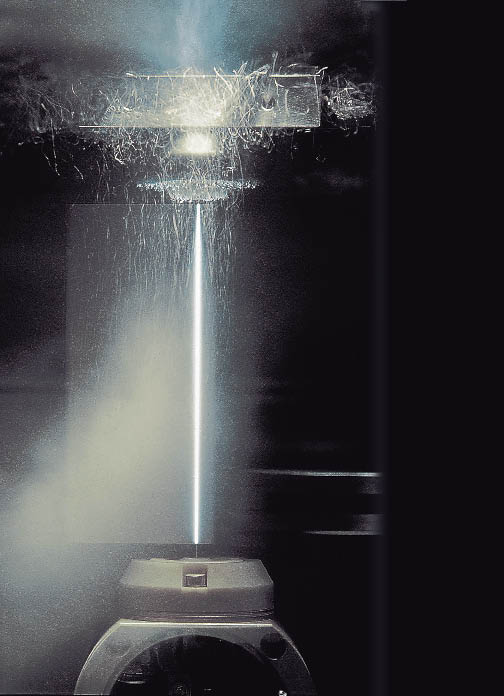
Courtesy of Gf AgieCharmilles
GF AgieCharmilles’ Clean Cut generator technology improves surface finishes and eliminates the “white layer.”
Ability to machine intricate geometries and hard materials drives growing use of wire EDM prototyping.
Roger Spice, president of Mercatech Inc., estimates that about 25 percent of his business is devoted to EDM prototyping—and the figure is growing.
“I do everything from airplane parts to artwork; and the type of jobs I 'm getting, with sharp corners and radiuses to contend with, can’t be machined in conventional ways,” he said. “In most cases, the design itself determines that the job be done by EDM prototyping.”
As parts get smaller, geometries more intricate and materials harder, EDM increasingly is the prototyping method of choice.
Improvements in EDM technology also have been key—and continual. Whereas EDM cutting speeds 10 years ago averaged about 28 sq. in. per hour, today that figure stands at about 42 sq. in. per hour, said Gisbert Ledvon, business development manager for GF AgieCharmilles, Lincolnshire, Ill.
The higher cutting speed is primarily due to improved generator technology that more efficiently manipulates sparks for removing material. Gisbert added that contemporary EDMs can impart finishes of 0.1μm Ra or better (vs. 0.3μm Ra a decade ago) and accuracies of ±1μm.
At Xact Wire EDM Corp., Waukesha, Wis., the technology’s capabilities and customers’ growing awareness of those benefits have helped increase its EDM prototyping business during the past 5 years, said Project Manager Diane Stamm. “EDM is ideally suited for prototypes because typically no special tooling is required,” she said. “The first part can be made fast and changes can be made fast.” In addition, “more people are becoming aware of the process. It’s been around for quite a while, but there are still many people who are not familiar with EDM.”
Wire EDM vaporizes material via a series of rapid electrical discharges delivered by a thin wire, usually brass. The procedure often is performed under water and the path of the wire is controlled by computer, which permits the sculpting of intricate geometries. While EDM can only work with conductive materials, it is especially effective machining hard metals.
Advantages
Prime among the benefits of EDM prototyping are its flexibility and cost savings. Xact’s Stamm cited the example of EDM prototyping a component profile for an aluminum extrusion. “With an aluminum extrusion, tooling can sometimes be very expensive if you aren 't quite sure what the final design is going to be,” Stamm said. “We can wire EDM a shorter version (up to 16 " tall) of the aluminum profile, make it as detailed as the customer needs and then see if that 's what they want.”
Using CAD/CAM software, adjustments can be made to the part geometry to achieve the needed profile before clients invest in tooling for production. While extrusion tooling can cost tens of thousands of dollars, Xact Wire can produce a test piece for just hundreds of dollars.
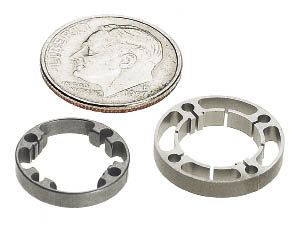
Courtesy of Xact Wire EDM
Xact Wire EDM used a GF AgieCharmilles 300 EDM to produce stainless steel rings used for endoscopes.
Equipped with 40 GF AgieCharmilles and Sodick EDMs, Xact Wire EDM serves the medical, aerospace, electronics, energy and packaging industries. And the company finds wide applications for EDM prototyping. “For parts that are getting smaller and smaller, especially for medical or aerospace, the machining choice moves closer to EDM,” said Stamm, adding that because EDM exerts no cutting force, it does not stress fragile and micro parts.
Endo Rings
The prototype components portrayed on this page are 17-4 PH stainless steel rings used in the fabrication of endoscopes. The ring on the left measures about ⅜ " in diameter and the other about ½ " in diameter. To wire EDM the parts, Xact input the client’s designs into a GF AgieCharmilles 300 machine. Xact also selected PEPS software for its CAD/CAM system to generate the CNC code for the EDM.
Using 0.008 " stratified wire, “we started with sheet stock and cut the ID and OD,” Stamm said. “As soon as you separate [a stainless steel part] from its parent material, it’s going to spring because stainless loves to move around.
“The wire releases any kind of stresses already in the material; usually it moves parallel to the surface about a couple thousandths of an inch.”
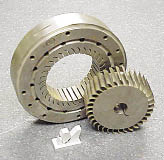
Courtesy of Mercatech
Mercatech machined a series of 2 "-long × 1⁄8 "-wide slots in the larger stainless steel aerospace component shown here.
Workers plan for the steel’s movement by leaving enough stock on the part to allow them to take two or three finish passes to attain the needed tolerances and geometries. Stamm estimated the smaller ring required about a half hour to EDM and the larger one about 45 minutes.
“Metals that tend to workharden or are very gummy are good candidates for EDM,” she continued. “Also, since you can EDM already-hardened metals, you don’t have to deal with heat treat distortion after [rough] machining.”
EDM’s prototyping versatility extends beyond fabricating small components. Xact Wire also EDMs large parts “to save expensive material,” said Stamm. “Rather than have the excess material turn into chips, we can return the piece of leftover material for later use by the customer.”
Many of the prototyping projects Mercatech takes on must be EDMed due to extremely tight tolerances and accuracies. “We also get a lot of jobs that will have one shape on the top of the U, V axis and another shape on the bottom of the X, Y axis,” Spice said. “This again requires the use of wire EDM, since the upper and lower heads can move independently of each other.” One job (below, left) called for machining a series of 2 "-long × ⅛ "-wide slots in a stainless steel aerospace component. “If you tried to machine that with an endmill, you would have radiuses in the corners and the client needed sharp corners,” Spice said.
After loading the part design into his EDM’s Esprit CAD/CAM software, Spice carefully inspected the component. “You have to check the part material for any deformities to make sure it’s flat when you put it into the machine—that’s critical,” he said. “If the customer wants the profile to match the squareness of the face plate you’re cutting the part from, it has to be flat. Then you line it up and clamp it down.” Spice used 3R rail clamping to secure the material.
He loaded 0.0010 " wire into his EDM’s headers. “On parts that are ground or machined flat, you want your heads as close to the part as possible,” he said. “If you have a lot of gap in there between the upper head and the top of the part surface, the flushing doesn’t work very well and it’s going to slow down the cutting process. We made that part in one cut, within ±0.001 ".”
Hard Metals
Another factor driving EDMing for prototypes has been the growing use of harder metals. “There’s been a trend during the last year or so, in aerospace in particular, where companies are [prototyping] new special alloys for jet engines and other components,” said GF AgieCharmilles’ Ledvon. “These materials are lighter, more wear resistant, tougher to break and very difficult to machine conventionally.”
Shops that did invest in expensive cutting tools for such jobs, he continued, often saw their tools wear due to material hardness after a pass or two. But because hardness is no obstacle for an EDM, the process has proven to be the more economical and effective solution for these emerging special alloys.
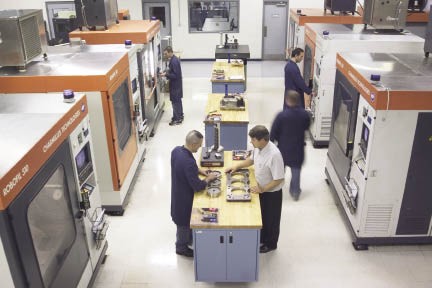
Courtesy of Xact Wire
Xact Wire EDM provides EDM prototypes for the medical, aerospace, electronics, energy and packaging industries.
“The biggest advantage of EDM prototyping is the consistency of the part,” Ledvon continued. “If you program a 3-D model and generate an ISO code for your wire EDM to cut a part today, and then 6 months from now that customer wants another part with the exact dimensions, finish and accuracy, you just bring the program back into the wire EDM and you will get the very same part.”
EDM Challenges
Despite EDM’s technological gains, fixturing remains a common challenge, especially for small, intricate parts. Numerical Precision Inc., Wheeling, Ill., a manufacturer of aerospace components, has developed a workholding solution that’s proven effective for many EDM prototype jobs. “One of the ways we’ve addressed [fixturing] is by using EDM tooling traditionally used for holding small electrodes,” said Karl Dahlstrom, vice president of manufacturing and engineering. “Instead of holding the electrodes with the tooling, we hold parts with it and we 're able to get repeatability.”
The other big challenge to EDM prototyping is the human factor. It’s important to work closely with the customer’s engineering and design staff to ensure that they’re “taking into account the limitations of their designs and how they can affect costs,” Dahlstrom said. “If you can lend a manufacturing perspective to the design process up front, it saves money for everyone and makes producing both prototypes and the production parts that much more achievable.”
While EDM technological improvements in recent years have helped widen the technology’s applications and usefulness, EDM makers and users alike are anticipating further advances in versatility and effectiveness.
GF AgieCharmilles’ Ledvon, for example, foresees a greater emphasis on combining EDM with other operations. “In other words, people might use high-speed, 5-axis milling to a certain degree on a particular part, and then switch over to wire EDM, or vice versa,” he said. “I do see a trend of people buying the latest and greatest technology and trying to combine it more. Also, the materials will continue to get harder and smaller.” CTE
About the Author: Daniel McCann is senior editor of Cutting Tool Engineering. He can be reached at [email protected] or (847) 714-0177.
Technology gains
While the emerging use of smaller and harder parts has played an important role in expanding EDM’s prototype applications, improvements to the technology have also been key to its growing use.
Traditionally, EDM left a white residue layer, a heat-affected zone, on workpieces. The residue was a portion of melted metal that remained on the surface. Over time and under stress, that layer could produce microcracks. To remedy the heat-affected zone problems, GF AgieCharmilles several years ago introduced its Clean Cut generator and, more recently, the IPG generator. The technology provides a new spark design and ignition voltage to produce finer sparks, which improve surface finishes and eliminate what’s known as the “white layer.”
The company also offers a servo controlled horizontal axis for its EDMs, which allows customers to simultaneously cut with up to 5 axes, an application not possible several years ago. The technology also "decreases fixturing costs and allows you to reach the part from five sides without resetting it,” said Gisbert Ledvon, the EDM builder’s business development manager. “That also increases accuracy and reduces labor costs because there 's less manual intervention in setting up multiple times. "
Most recently, AgieCharmilles developed an EDM technology to alternately rough and then finish material. “We introduced the Twin Wire technology a few years ago,” Ledvon said. “Small wires can be limited in how quickly they cut, yet they 're required for parts with very small details that you can 't get into with larger wire.” The Twin Wire technology, he added, allows shops to rough with a large wire, and then automatically switch to a microwire to cut intricate details.
Another EDM manufacturer, Makino Inc., Mason, Ohio, 2 years ago introduced its High Energy Applied Technology (HEAT) for wire EDM to boost cutting speed by 50 percent in poor or difficult cutting conditions while holding tolerances to 0.0002 " (with two passes).
This new technology features "two independent flushing pumps, one dedicated to the upper head and one to the lower head,” said Brian Pfluger, Makino 's EDM applications team leader. “This unique pump configuration allows the HEAT technology to basically grab and harness all the available horsepower from these pumps to increase both flushing pressure and volume to increase machining speeds on detached or poor-flush machining situations.”
Makino also reports that the technology increases skim speeds by 50 to 100 percent in nonsealed nozzle applications, uneven surfaces and through-holes in parts up to 12 " tall.
—D. McCann
Bright EDM forecast
The growing popularity of EDM prototyping is only one aspect of the wider application of the technology. According to a 2006 EDM market study conducted by the consulting and analysis firm Frost & Sullivan, San Antonio, EDM manufacturing, in general, promises continued growth. "EDMs can do a far more precise job [compared to conventional machining] in lesser time due to their contactless machining process, making them the preferred option with many end-user industries,” according to Frost & Sullivan. “Moreover, EDMs use the spark erosion technology that enables the machining to be carried out with ease and eliminates the need for a further finishing process.”
Frost & Sullivan forecasts a compound annual growth rate of 6.9 percent for sales of EDMs through 2012. The technology’s top three market drivers are:
- Increasing need for complex and faster designs,
- Increasing efficiency and faster turnaround times, and
- Ability to integrate CAD.
The top two market restraints for EDM technology are:
- High initial cost and availability of refurbished machines
- Limited applications for end users (“EDMs have their limitations for normal applications due to end-user perceptions on economies of scale and reliance on normal machining techniques,” according to J. Arunkumar, Frost & Sullivan program manager for industrial automation and process controls.)
The consulting firm also suggested that to solidify further demand for EDMing, end users must continually be educated about advances in the technology. “Vendors need to promote the benefits of the latest EDM technologies that include the ability to machine nano parts, download CAD files directly and convert them into machine codes and drill fine holes. As customers realize the advantages of these technologically superior machines that can perform multiple functions, EDMs are expected to witness greater demand.”
—D. McCann
Contributors
GF AgieCharmilles LLC
(847) 913-5300
us.gfac.com
Makino Inc.
(800) 552-3288
www.makino.com
Mercatech Inc.
(972) 247-1821
www.mercatech.com
Numerical Precision Inc.
(847) 394-3610
www.numericalprecision.com
Xact Wire EDM Corp.
(800) 798-9228
xactedm.com
Related Glossary Terms
- 3-D
3-D
Way of displaying real-world objects in a natural way by showing depth, height and width. This system uses the X, Y and Z axes.
- alloys
alloys
Substances having metallic properties and being composed of two or more chemical elements of which at least one is a metal.
- computer numerical control ( CNC)
computer numerical control ( CNC)
Microprocessor-based controller dedicated to a machine tool that permits the creation or modification of parts. Programmed numerical control activates the machine’s servos and spindle drives and controls the various machining operations. See DNC, direct numerical control; NC, numerical control.
- computer-aided design ( CAD)
computer-aided design ( CAD)
Product-design functions performed with the help of computers and special software.
- cutting force
cutting force
Engagement of a tool’s cutting edge with a workpiece generates a cutting force. Such a cutting force combines tangential, feed and radial forces, which can be measured by a dynamometer. Of the three cutting force components, tangential force is the greatest. Tangential force generates torque and accounts for more than 95 percent of the machining power. See dynamometer.
- cutting speed
cutting speed
Tangential velocity on the surface of the tool or workpiece at the cutting interface. The formula for cutting speed (sfm) is tool diameter 5 0.26 5 spindle speed (rpm). The formula for feed per tooth (fpt) is table feed (ipm)/number of flutes/spindle speed (rpm). The formula for spindle speed (rpm) is cutting speed (sfm) 5 3.82/tool diameter. The formula for table feed (ipm) is feed per tooth (ftp) 5 number of tool flutes 5 spindle speed (rpm).
- electrical-discharge machining ( EDM)
electrical-discharge machining ( EDM)
Process that vaporizes conductive materials by controlled application of pulsed electrical current that flows between a workpiece and electrode (tool) in a dielectric fluid. Permits machining shapes to tight accuracies without the internal stresses conventional machining often generates. Useful in diemaking.
- endmill
endmill
Milling cutter held by its shank that cuts on its periphery and, if so configured, on its free end. Takes a variety of shapes (single- and double-end, roughing, ballnose and cup-end) and sizes (stub, medium, long and extra-long). Also comes with differing numbers of flutes.
- extrusion
extrusion
Conversion of an ingot or billet into lengths of uniform cross section by forcing metal to flow plastically through a die orifice.
- face plate
face plate
Flat, round workholder with slots used to hold regular- or irregular-shaped stock. If stock is markedly asymmetrical, counterbalances may be needed to prevent vibration.
- flat ( screw flat)
flat ( screw flat)
Flat surface machined into the shank of a cutting tool for enhanced holding of the tool.
- gang cutting ( milling)
gang cutting ( milling)
Machining with several cutters mounted on a single arbor, generally for simultaneous cutting.
- hardness
hardness
Hardness is a measure of the resistance of a material to surface indentation or abrasion. There is no absolute scale for hardness. In order to express hardness quantitatively, each type of test has its own scale, which defines hardness. Indentation hardness obtained through static methods is measured by Brinell, Rockwell, Vickers and Knoop tests. Hardness without indentation is measured by a dynamic method, known as the Scleroscope test.
- heat-affected zone
heat-affected zone
That portion of the base metal that was not melted during brazing, cutting or welding, but whose microstructure and mechanical properties were altered by the heat.
- inner diameter ( ID)
inner diameter ( ID)
Dimension that defines the inside diameter of a cavity or hole. See OD, outer diameter.
- milling
milling
Machining operation in which metal or other material is removed by applying power to a rotating cutter. In vertical milling, the cutting tool is mounted vertically on the spindle. In horizontal milling, the cutting tool is mounted horizontally, either directly on the spindle or on an arbor. Horizontal milling is further broken down into conventional milling, where the cutter rotates opposite the direction of feed, or “up” into the workpiece; and climb milling, where the cutter rotates in the direction of feed, or “down” into the workpiece. Milling operations include plane or surface milling, endmilling, facemilling, angle milling, form milling and profiling.
- outer diameter ( OD)
outer diameter ( OD)
Dimension that defines the exterior diameter of a cylindrical or round part. See ID, inner diameter.
- parallel
parallel
Strip or block of precision-ground stock used to elevate a workpiece, while keeping it parallel to the worktable, to prevent cutter/table contact.
- sawing machine ( saw)
sawing machine ( saw)
Machine designed to use a serrated-tooth blade to cut metal or other material. Comes in a wide variety of styles but takes one of four basic forms: hacksaw (a simple, rugged machine that uses a reciprocating motion to part metal or other material); cold or circular saw (powers a circular blade that cuts structural materials); bandsaw (runs an endless band; the two basic types are cutoff and contour band machines, which cut intricate contours and shapes); and abrasive cutoff saw (similar in appearance to the cold saw, but uses an abrasive disc that rotates at high speeds rather than a blade with serrated teeth).
- wire EDM
wire EDM
Process similar to ram electrical-discharge machining except a small-diameter copper or brass wire is used as a traveling electrode. Usually used in conjunction with a CNC and only works when a part is to be cut completely through. A common analogy is wire electrical-discharge machining is like an ultraprecise, electrical, contour-sawing operation.


